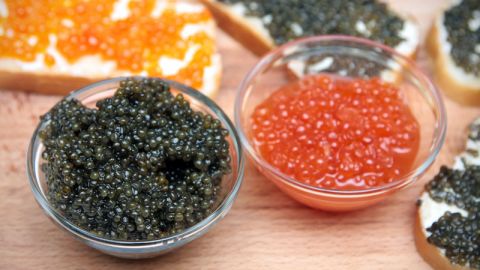The luxurious world of caviar
2024-10-16 13:57:33
In the realm of culinary indulgence, few delicacies evoke the same level of opulence and refinement as caviar. Originating from the roe of the sturgeon fish, caviar has been revered for centuries as a symbol of luxury and prestige. From the royal courts of ancient Persia to the lavish banquets of modern-day billionaires, the allure of caviar has remained timeless, captivating the palates of epicures around the globe.

A Brief History
The history of caviar traces back thousands of years, with its origins rooted in the Caspian and Black Sea regions. Ancient civilizations, including the Persians and the Greeks, prized sturgeon roe for its rich flavor and purported medicinal properties. Over time, caviar became synonymous with wealth and status, often reserved for royalty and nobility.
During the Middle Ages, the demand for caviar soared across Europe, leading to the establishment of lucrative trade routes along the Caspian Sea. Russian tsars indulged in the finest varieties of caviar, further cementing its association with aristocracy. However, overexploitation and environmental degradation threatened the sturgeon population, prompting the implementation of conservation measures in the 20th century.
Today, caviar production is carefully regulated, with sustainable aquaculture practices ensuring the preservation of sturgeon species. While the traditional heartlands of caviar production remain in the Caspian and Black Sea regions, countries such as France, Italy, and the United States have emerged as prominent producers, offering a diverse range of caviar varieties to discerning consumers.
The Art of Caviar Tasting
Savoring caviar is an experience that transcends the mere act of eating; it is a sensory journey that engages the palate and ignites the senses. The first step in appreciating caviar is understanding its complex flavor profile, which can vary depending on the species of sturgeon, the location of the farm, and the processing methods employed.
Upon presentation, caviar is typically served chilled on a bed of ice, accompanied by blinis, creme fraiche, and finely chopped onions or chives. The traditional utensil for enjoying caviar is a mother-of-pearl spoon, as metal utensils can alter the delicate taste of the roe.
To fully appreciate the nuances of caviar, connoisseurs employ a method known as caviar tasting,which involves sampling different varieties side by side. This allows for the comparison of flavors, textures, and aromas, enabling enthusiasts to discern subtle differences between each type of caviar.
Varieties of Caviar
While beluga, ossetra, and sevruga are the most well-known types of caviar, there exists a wide array of lesser-known varieties that offer unique culinary experiences.
Beluga Caviar: Revered as the king of caviar, beluga caviar is prized for its large, lustrous pearls and buttery texture. With a flavor profile characterized by hints of butter, cream, and the sea, beluga caviar is a true indulgence reserved for special occasions.
Ossetra Caviar: Known for its medium-sized grains and nutty flavor, ossetra caviar is a favorite among caviar enthusiasts. The roe ranges in color from golden to dark brown, with each hue imparting its own distinct taste and aroma.
Sevruga Caviar: Smaller in size compared to beluga and ossetra, sevruga caviar boasts a bold, briny flavor with a slightly tangy finish. Its petite grains offer a satisfying pop on the palate, making it a popular choice for garnishing dishes or enjoying on its own.
Sterlet Caviar: Harvested from the sterlet sturgeon, this rare variety of caviar is prized for its delicate flavor and velvety texture. Sterlet caviar features small, translucent pearls with a subtle sweetness that pairs beautifully with champagne or vodka.
Siberian Sturgeon Caviar: Cultivated from Siberian sturgeon raised in sustainable aquaculture facilities, this caviar offers a more accessible option for discerning consumers. With its smooth, creamy texture and clean, briny finish, Siberian sturgeon caviar is perfect for both novice and experienced caviar enthusiasts.
Pairing Caviar with Champagne
For centuries, champagne has been the beverage of choice to accompany caviar, with its effervescence and acidity serving as the perfect foil to the rich, salty flavors of the roe. When selecting a champagne to pair with caviar, opt for a brut or extra brut style, as the dryness of these wines complements the caviar without overwhelming its delicate taste.
Champagnes made from Chardonnay grapes are particularly well-suited for pairing with caviar, as their crisp acidity and citrus notes enhance the freshness of the roe. Blanc de Blancs champagnes, which are made exclusively from Chardonnay grapes, offer a purity of flavor that elevates the caviar tasting experience.
The Future of Caviar
As the demand for sustainable and ethically sourced ingredients continues to rise, the caviar industry is evolving to meet the needs of conscientious consumers. Aquaculture practices are being refined to minimize environmental impact, while innovative techniques such as caviar aging are enhancing the flavor and texture of the roe.
Furthermore, advancements in technology are enabling greater transparency and traceability within the caviar supply chain, allowing consumers to make informed choices about the products they purchase. From farm to table, caviar producers are committed to upholding the highest standards of quality and integrity, ensuring that this cherished delicacy continues to delight palates for generations to come.
In conclusion, caviar remains a symbol of extravagance and refinement, captivating the imaginations of epicures and gourmands alike. Whether enjoyed as a decadent appetizer, a luxurious garnish, or a standalone delicacy, caviar offers a gastronomic experience like no other, inviting us to savor the essence of indulgence with every exquisite bite.












